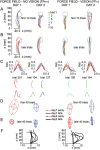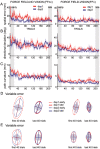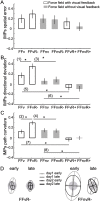Differences in context and feedback result in different trajectories and adaptation strategies in reaching
- PMID: 19148302
- PMCID: PMC2625444
- DOI: 10.1371/journal.pone.0004214
Differences in context and feedback result in different trajectories and adaptation strategies in reaching
Abstract
Computational models of motor control have often explained the straightness of horizontal planar reaching movements as a consequence of optimal control. Departure from rectilinearity is thus regarded as sub-optimal. Here we examine if subjects may instead select to make curved trajectories following adaptation to force fields and visuomotor rotations. Separate subjects adapted to force fields with or without visual feedback of their hand trajectory and were retested after 24 hours. Following adaptation, comparable accuracies were achieved in two ways: with visual feedback, adapted trajectories in force fields were straight whereas without it, they remained curved. The results suggest that trajectory shape is not always straight, but is also influenced by the calibration of available feedback signals for the state estimation required by the task. In a follow-up experiment, where additional subjects learned a visuomotor rotation immediately after force field, the trajectories learned in force fields (straight or curved) were transferred when directions of the perturbations were similar but not when directions were opposing. This demonstrates a strong bias by prior experience to keep using a recently acquired control policy that continues to produce successful performance inspite of differences in tasks and feedback conditions. On relearning of force fields on the second day, facilitation by intervening visuomotor rotations occurred only when required motor adjustments and calibration of feedback signals were similar in both tasks. These results suggest that both the available feedback signals and prior history of learning influence the choice and maintenance of control policy during adaptations.
Conflict of interest statement
Figures







References
Publication types
MeSH terms
LinkOut - more resources
Full Text Sources
Molecular Biology Databases

